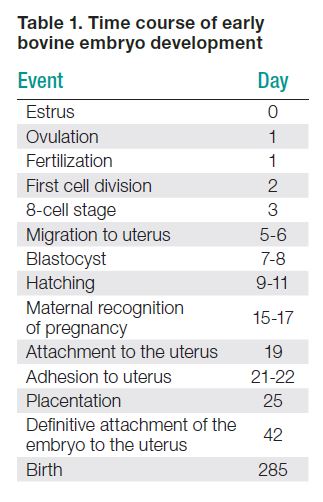Embryonic loss is the greatest economic loss in the beef cow/calf industry. Therefore, your management decisions around breeding time should consider factors that may influence embryonic mortality and calf survivability, including timing of animal transport as well as heat stress.
In this article, Sarah Fields, a previous Graduate Research Assistant in Beef Production, and Dr. George Perry, Beef Reproduction & Management Specialist with SDSU Animal & Range Sciences, help you better understand the effects of stress on embryonic mortality so you can make management decisions that minimize its impact.
Embryonic development
In order to understand how stress may increase embryonic mortality, you must first understand the development of the embryo (Table 1).
Just like the estrous cycle, embryo development begins on day 0, or the day of standing estrus. This is the day the female is receptive to the male and insemination occurs. Ovulation occurs on day 1 or about 30 hours after the first standing mount (Wiltbank et al., 2000). If viable sperm is present, fertilization occurs inside the oviduct shortly after ovulation. The first cell division occurs on day 2, and by day 3 the embryo has reached the 8-cell stage (Shea, 1981). Between days 5 and 6 the embryo migrates into the uterine horn and by day 7 to 8 it forms into a blastocyst (Shea, 1981; Flechon and Renard, 1978; Peters, 1996). At this stage two distinct parts of the embryo can be seen: 1) the inner cell mass, which will become the fetus and 2) the trophoblast, which become the placenta.
Between days 9 and 11 the embryo hatches from the zona pellucida, a protective shell that has surrounded the embryo to this point (Shea, 1981; Peters, 1996). Then, on days 15 to 17, the embryo sends a signal to the cow to tell her she is pregnant (Peters, 1996). This is the first signal the cow receives to know she is pregnant. The embryo attaches to the uterus beginning on day 19, and around day 25, placentation, an intricate cellular interface between the cow and the calf, begins. By day 42 the embryo has fully attached to the uterus of the cow (Peters, 1996).

Shipping stress and embryonic mortality
With knowledge of the critical time points in embryonic development, it becomes easier to understand how stress from shipping can result in increased embryonic mortality in cows (Table 2).

When you load your animals on a trailer and haul them to a new location, they become stressed and release hormones related to stress. These hormones lead to a release of different hormones that change the uterine environment where the embryo is developing. During blastocyst formation, hatching, maternal recognition of pregnancy, and attachment to the uterus, the embryo is vulnerable to these changes.
These most critical time points are between days 5 and 42 after insemination. Before day 5, the embryo is in the oviduct and is not subject to changes in the uterine environment. Therefore, stress does not influence embryo survivability at this time.
The greater the length of time after day 42, the less severe the influence of shipping stress on embryonic loss appears to be. At the time of complete attachment of the embryo to the uterus the embryo is supported by the mother and appears to be not as easily affected by changes in its environment. On the other hand, between these time points (5-42 days), the embryo is at greatest risk.
When should cows not be shipped?
Shipping cows between days 5 and 42 can be detrimental to embryo survival and cause around a 10% decrease in pregnancy rates (Table 2). Research has also demonstrated that shipping cattle 45 to 60 days after insemination can result in 6% of embryos being lost. Therefore, even shipping cattle 45 to 60 days after insemination may increase embryonic mortality.
Critical time points such as blastocyst formation, hatching, maternal recognition of pregnancy and adhesion to the uterus take place during the time of pregnancy. If these events are disturbed, it leads to increased embryonic mortality and decreased pregnancy rates. Therefore, it is important for you to transport cattle before the breeding season or immediately after insemination.
When can cows be shipped?
Shipping between days 1-4 is best. The embryo is still in the oviduct during this time and therefore likely not subjected to uterine changes.
After day 45, the embryo is well established and fully attached with the placenta. Therefore, it is less susceptible to the changes resulting from stress as well. Shipping at this point is less risky; however, embryonic loss from shipping has been reported up to 60 days after insemination. Take care to reduce the stress involved when animals are shipped. Do not overcrowd trailers. Handle cattle as gently and calmly as possible.
Heat stress and embryonic mortality
The best time to ship cattle is during early stages of embryonic development. However, this is also when the embryo is most susceptible to increased temperatures. Temperature, humidity, radiant heat and wind all affect heat stress in cows.
The rectal temperature of cattle is normally 102.2°F. An increase in rectal temperature as little as 2°F can result in decreased embryonic development (Ulberg and Berfening, 1967). When those temperatures reach 105.8°F for as little as 9 hours on the day of insemination, embryonic development can be compromised (Rivera and Hansen, 2001).
Heat stress has also been reported to change follicular waves, resulting in reduced oocyte quality (Wolfenson et al., 1995). Researchers have reported heat stress 42 days prior (Al-Katanani et al., 2001) and up to 40 days after breeding can affect pregnancy rates (Cartmill et al., 2001). This illustrates how important it is to plan ahead for the breeding season.
There are several ways to reduce the effects of heat stress. Shade, fans and misters can all reduce the effects of heat stress in natural service or artificial insemination (A.I.) programs. These methods allow animals to stay cooler during the hottest parts of the day. In humid areas, misters may not actually benefit animals. If the water cannot evaporate, it is not effective at cooling the animal.
Producers who utilize A.I. can also implement timed A.I. (T.A.I.) protocols to increase pregnancy rates during the hot summer months. Timed A.I. has increased pregnancy rates over animals inseminated 12 hours after estrus detection in conditions of heat stress (Arechiga et al., 1998; de la Sota et al., 1998). This is most likely due to fewer animals showing signs of estrus when under heat stress. When the weather is too hot, animals tend to not move around as much and do not show signs of standing estrus. Heat detection is a vital part of getting more animals pregnant. Since fewer animals are seen in heat, fewer animals can be inseminated. In this case, T.A.I. would be the best protocol to use, because it eliminates heat detection.
Using embryo transfer during times of heat stress can also increase pregnancy rates. High–quality, fresh embryos have been proven to increase pregnancy rates over A.I. in heat–stressed cows (Putney et al., 1989). Embryos at time of embryo transfer can adapt to the elevated temperatures. Therefore, use of embryo transfer during times of heat stress can improve pregnancy success.
Planning for success
Getting cows and heifers pregnant during the breeding season – especially early in the breeding season – can have a tremendous impact on your profitability levels. You’ve already put forth the time, effort and cost to have a successful breeding season (natural service or A.I.). Ensure your management decisions lead to success too. Don’t stress animals during critical time points in embryo development. Consider heat stress and shipping stress as well. In short, planning around the breeding season becomes an important management tool for you to maximize pregnancy success.
By: Sarah Fields, Graduate Research Assistant in Beef Production, and Dr. George Perry, Beef Reproduction & Management Specialist, SDSU Animal & Range Sciences


